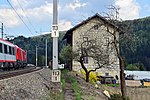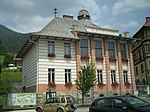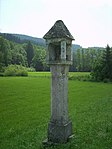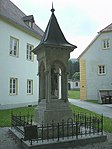List of listed objects in Spital am Semmering
The list of listed objects in Spital am Semmering contains the 17 listed , immovable objects of the Austrian municipality of Spital am Semmering in the Styrian district of Bruck-Mürzzuschlag .
Monuments
| photo | monument | Location | description | Metadata |
|---|---|---|---|---|

|
Southern line "Semmering-Bahn" (Gloggnitz-Mürzzuschlag) ObjectID: 9754 |
Grautschenhof 31 KG location : Schöneben-Spital |
The Semmering Railway was opened in 1854 and is the oldest standard-gauge mountain railway in Europe. It was planned by Carl Ritter von Ghega . From the train station Gloggnitz to station Mürzzuschlag it 41 kilometers. In the area of the cadastral community of Schöneben-Spital there are two route supervision structures. |
ObjektID: 9754 Status: Notification Status of the BDA list: 2020-02-29 Name: Southern line "Semmering-Bahn" (Gloggnitz-Mürzzuschlag) GstNr .: 819/1; .19 / 2; .24 / 2; .87 |

|
Kilometer / milestone ObjectID: 9742 |
Semmering pass height location KG: Semmering |
The obelisk or milestone marked the end of the Lower Austrian section of the then Imperial and Royal Italian Post and Main Commercial Road, 12½ miles from Vienna. It is intended to commemorate the first basic survey in the entire territory of the monarchy, which was started in 1762. |
ObjectID: 9742 Status: § 2a Status of the BDA list: 2020-02-29 Name: Kilometer / milestone GstNr .: 74/6 |

|
Personality monument, Nittner monument ObjectID : 9743 |
Semmering pass height location KG: Semmering |
Memorial stone for the aviation pioneer and KuK Oberleutnant Eduard Nittner who crossed the Semmering Pass with an Etrich Taube on May 3, 1912 on the flight from Wiener Neustadt to Graz . Nittner was the first pilot to fly over an Alpine pass in Austria. |
ObjectID : 9743 Status: § 2a Status of the BDA list: 2020-02-29 Name: Personality monument, Nittner monument GstNr .: 74/4 Eduard Nittner monument, Spital am Semmering |

|
Southern railway line "Semmering-Bahn" (Gloggnitz-Mürzzuschlag) ObjectID : 24867 |
Steinhaus am Semmering 7, 28 KG location : Semmering |
The Semmering Railway was opened in 1854 and is the oldest standard-gauge mountain railway in Europe. It was planned by Carl Ritter von Ghega . From the train station Gloggnitz to station Mürzzuschlag it 41 kilometers. In the area of the cadastral community of Semmering there is the Steinhaus stop and a total of six route monitoring structures. |
ObjectID : 24867 Status : Notification Status of the BDA list: 2020-02-29 Name: Southern line "Semmering-Bahn" (Gloggnitz-Mürzzuschlag) GstNr .: 699/1; 699/2; .9; .12 / 2; .13 / 3; .17 / 4; .25; .22 / 1; .29 |

|
Erzstollen Object ID: 9738 |
Steinhaus, Fröschnitz KG location : Semmering |
The ore tunnel is located above the Alfred hut in the Fröschnitztal. |
ObjectID : 9738 Status: § 2a Status of the BDA list: 2020-02-29 Name: Erzstollen GstNr .: 679/11 |

|
Melting furnace, former melting furnace "Alfred-Hütte" ObjektID: 9739 |
Steinhaus, Fröschnitz KG location : Semmering |
Built in 1838/1839 on behalf of Prince Alfred von Schönburg-Hartenstein to process the ore from the Fröschnitz and Dürgraben pits, which previously had to be laboriously transported to Aue near Schottwien for smelting . In 1844 it became the property of Josef Ritter von Wachtler, who modernized it. At full operation, around 18-20 workers could be employed. On average, 3000 tons of pig iron were produced here per year. In the 1870s, cast goods were also produced in two cupolas . Due to excessive competitive pressure, a lack of charcoal and ores of sufficient quality, operations in the Alfredhütte had to be stopped again in 1885. In order to stop the further decline of this industrial monument, the hut was restored and conserved from 2002 to 2003 by the Steinhaus am Semmering beautification association, with the support of the municipality of Spital and the province of Styria. |
ObjectID: 9739 Status: § 2a Status of the BDA list: 2020-02-29 Name: Melting furnace, former melting furnace "Alfred-Hütte" GstNr .: .39 / 6 Alfredhütte Steinhaus |

|
Event memorial, so-called Carolus memorial ObjectID : 9741 |
Zauberberg 1 KG location : Semmering |
Built in 1728 on behalf of the Austrian Estates in honor of Emperor Karl VI. who, on the occasion of his trip to Trieste, had a new road route built over the Semmering Pass in just 48 days. After a six-day stay in Schottwien , the emperor and his wife and entourage were able to cross the Semmering on the new route on June 21, 1728 without incident. The globe with the insignia of the reigning emperor sits enthroned on the base: Carolus VI. As guardian symbols, four eagles look in all directions. The memorial is about 50 meters away from today's state road. |
ObjectID : 9741 Status: § 2a Status of the BDA list: 2020-02-29 Name: Event monument , Sogen. Carolus Monument GstNr .: 65/12 Carolus Monument, Semmering |

|
Town Hall / Municipal Office ObjectID: 9716 |
Bundesstrasse, Spital 16 KG location : Spital am Semmering |
The building, built in 1906 in Art Nouveau style based on plans by the Viennese architect Gürtler, was inaugurated in 1907 and given its intended purpose. A remarkable structural detail are the four roof surfaces on the east side, one above the other. Ludwig Zatzka took over the cost of furnishing the conference room ; the armchairs, the tiled stove and the clock have been preserved to this day. The municipal office was renovated several times, in 1962 the facade was painted green, and another exterior renovation took place in 1981/1982. Between 1986 and 1987 the interior was also extensively renovated. The current facade design was added in 1995, in 2004 the offices were also redesigned and made more functional and a citizen service area set up. |
ObjectID: 9716 Status: § 2a Status of the BDA list: 2020-02-29 Name: City Hall / Municipal Office GstNr .: .27 |

|
Wayside shrine Hofwiesenkreuz ObjectID : 9719 |
Grautschenhof location KG: Spital am Semmering |
The Hofwiesenkreuz is a medieval light pillar in Gothic style with a tabernacle structure and pyramid roof, comparable to the Wartholz cross in Reichenau an der Rax . The court meadow cross was originally crowned with a stone cross. It probably served as a meeting point for the population to receive the abbot of Neuberg Abbey when he visited the hospital. It is possible that the plague dead were once buried here. |
ObjectID : 9719 Status: § 2a Status of the BDA list: 2020-02-29 Name: wayside shrine GstNr .: 362/1 |

|
Sommerau Castle, formerly the Franz Jawornik Home of the Styrian War Victims Association. ObjectID : 9718 |
Grautschenhof 7 KG location : Spital am Semmering |
The castle stands on the ground of one of the oldest farms in the municipality, the Pruggenbauer or Stockreiterhof, which has been known since 1331. In 1881 the property came into the possession of the Landauer family, who demolished the farm buildings in 1884 and had the Landhaus Sommerau built in its place. In 1894 the villa came into the possession of the Hungarian magnate Geza Count Brunsvik de Koromba, who finally expanded it into a castle for 50,000 guilders according to plans by the Graz architect Jellinek. In 1902 the property was sold to the Holzmann et Companie company and converted into a luxury hotel. In 1906 the castle went to Arthur Horny, who again used it exclusively as a country and administrative seat for his goods. In the Third Reich, a forestry school was set up here from 1939, and from 1945 the building served as a military hospital for the German Wehrmacht . In 1951 the Styrian War Victims Association (KOV) took over the castle and opened a holiday home for war orphans and victims here. The home was named after the Graz city councilor Franz Jawornik, who had made a special contribution to war invalids and returnees. In 1978/1979 the facility was expanded to include a swimming pool and a small café. The youth and family hotel "Jufa Semmering" has been located in Schloss Sommerau since 2011. |
ObjectID : 9718 Status : Notification Status of the BDA list: 2020-02-29 Name: Schloss Sommerau, Franz-Jawornik-Heim des Kriegsopferverband Styria. GstNr .: .157 |

|
Zatzka Chapel / Stone Wall Chapel ObjectID: 9720 |
Obere Bahnstrasse location KG: Spital am Semmering |
The chapel, built in the neo-Romanesque style in 1904, was commissioned by the Viennese city architect Ludwig Zatzka and is also known under the name "Maria an der Steinwand". It was often wrongly called a Protestant place of worship. It was inaugurated in 1905 by Pastor Carl Oedl. In the same year, the Zatzka couple celebrated their golden wedding anniversary. The Zatzakapelle also had a mass license , which was confirmed in 1913, 1921, 1943 and again in 1953. Masses and especially May services of the parish hospital took place here again and again. From the beginning of the Second World War, the chapel was no longer used and left to decay. Renovation attempts by the community and the fire brigade in the 1970s failed due to the veto of a single co-owner. In the mid-1990s, however, it was possible to remove all obstacles and the chapel was completely renovated through cooperation between the landowners, the Federal Monuments Office and the municipality and thus preserved for posterity. |
ObjectID: 9720 Status: Notification Status of the BDA list: 2020-02-29 Name: Zatzka-Kapelle GstNr .: .8 |

|
Southern line "Semmering-Bahn" (Gloggnitz-Mürzzuschlag) ObjectID : 9747 |
Obere Bahnstrasse 1, 2 KG location : Spital am Semmering |
The Semmering Railway was opened in 1854 and is the oldest standard-gauge mountain railway in Europe. It was planned by Carl Ritter von Ghega . From the train station Gloggnitz to station Mürzzuschlag it 41 kilometers. In the area of the cadastral community of Spital am Semmering there is the Spital am Semmering train station and a total of five route monitoring structures. |
ObjectID : 9747 Status : Notification Status of the BDA list: 2020-02-29 Name: Southern line "Semmering-Bahn" (Gloggnitz-Mürzzuschlag) GstNr .: .65 / 5; .65 / 4; 1256/1; .64; .65 / 3; .65 / 2; .65 / 1; .101 / 2; .108 / 1; 1256/2 |

|
Wayside shrine Johanneskreuz ObjectID : 9714 |
Stuhleckstrasse 1 KG location : Spital am Semmering |
Since 1760 there has been a Johannes Nepomuk chapel on this place, which was supposed to protect against flooding and also served as a conductor cross . In 1887 the pavement and road into the Kaltenbach was extended and the chapel was demolished. In the same year the foundation stone was laid for a new building which, however, could not be completed until 1902 due to a lack of willingness to donate. The chapel body made of Aflenz sandstone was created by the Graz sculptor and stonemason Ferdinand Haugeneder, the 1.26 m high statue is the work of the Graz sculptor Petrus Neuböck and is made of Savannier sandstone from France. In 1988 the chapel was restored. |
ObjectID : 9714 Status: § 2a Status of the BDA list: 2020-02-29 Name: Bildstock GstNr .: 22/1 |

|
Rectory ObjectID: 9711 |
Stuhleckstrasse 1 KG location : Spital am Semmering |
ObjectID: 9711 Status: § 2a Status of the BDA list: 2020-02-29 Name: Pfarrhof GstNr .: .14 |
|

|
Manor, outbuilding of the rectory ObjectID: 9712 |
Stuhleckstraße 2 KG location : Spital am Semmering |
ObjectID: 9712 Status: § 2a Status of the BDA list: 2020-02-29 Name: Gutshof, outbuilding d. Pfarrhofs GstNr .: .14 |
|

|
Catholic parish church Mariae Himmelfahrt ObjectID : 9709 |
Location KG: Spital am Semmering |
Built in 1160 and inaugurated in 1163 by Archbishop Eberhard von Salzburg . The sacred building went through a total of three major construction periods: Romanesque, "transition style" (between Romanesque and early Gothic) and late Gothic. Extensive renovation measures were carried out between 1957 and 1967. In 1989 the badly dilapidated west portal was renovated, the last exterior renovation took place from 2002 to 2003. |
ObjectID : 9709 Status: § 2a Status of the BDA list: 2020-02-29 Name: Catholic Parish Church Mariae Himmelfahrt GstNr .: .15 Parish Church Spital am Semmering |

|
Churchyard / former cemetery, cemetery wall ObjektID: 9710 |
Bundesstrasse, Spital 16 KG location : Spital am Semmering |
ObjectID: 9710 Status: § 2a Status of the BDA list: 2020-02-29 Name: Kirchhof / Friedhof former, Friedhofsmauer GstNr .: .15; 22/5; 8th |
literature
- Bernhard A. Reismann: History of the community Spital am Semmering. Spital am Semmering 1997.
- Bernhard A. Reismann: History of the community Spital am Semmering, a cultural landscape and its people , Volumes I and II, Community Spital / Semmering 2010.
Web links
Commons : Listed objects in Spital am Semmering - collection of images, videos and audio files
Individual evidence
- ↑ a b Styria - immovable and archaeological monuments under monument protection. (PDF), ( CSV ). Federal Monuments Office , as of February 18, 2020.
- ↑ Information board on site
- ↑ Information board on site
- ↑ Bernhard Reismann: II, 2010, pp. 205–207
- ↑ Bernhard Reismann: 1997, p. 101.
- ↑ Bernhard Reismann: 2010, I, p. 88
- ↑ Bernhard Reismann: 1997, pp. 396-402, 2010, II, pp. 71-81
- ↑ § 2a Monument Protection Act in the legal information system of the Republic of Austria .
